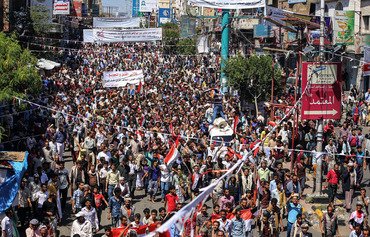As part of its efforts to prevent the further deterioration of the value of the Yemeni riyal, the Central Bank of Yemen in Aden has established a single money transfer network.
In late September, the bank banned local money transfer networks, in a move designed to discourage the speculation that is contributing to high inflation.
One of the reasons for the deterioration of the national currency is that there are now two central banks in Yemen, one in Aden and another in Sanaa, Studies and Economic Media Centre chairman Mustafa Nasr told Al-Mashareq.
These two entities, acting respectively for Yemen's legitimate government and the Iran-backed Houthis (Ansarallah), impose decisions and regulations in their separate areas of control, he said.
This has led to a situation where the dollar/riyal exchange in government-controlled areas is currently more than 800 riyals/dollar, while in Houthi-controlled areas it is 605 riyals/dollar, he said.
Nasr said this discrepancy stems at least in part from the Houthis' January decision to ban the use of new banknotes printed by the Central Bank in Aden.
"The government should adopt fiscal policies that would unify the fiscal and monetary policy and address the split and duplication of the financial and monetary decision-making process," he said.
Additional factors that have contributed to the decline in the value of Yemen's national currency are "the repercussions of the coronavirus, the effects of the war and cessation of production", Nasr said.
These have contributed, "in one way or another, to a gradual deterioration of the currency's value in the banking market", he noted.
Reducing irregularities
Political analyst Faisal Ahmed told Al-Mashareq the new measures introduced by the Central Bank in Aden "partially address the problem for a short period of time, especially given the near depletion of the Saudi deposit".
"Supporting the value of the Yemeni riyal requires taking broader measures with the intervention of [Arab] coalition countries, led by Saudi Arabia, to support the bank with deposits in foreign currencies," he said.
Proposals to boost the value of the riyal include a return to the export of oil and gas "and activating all productive sectors that are an important source of hard currency for the national economy", economist Abdul Aziz Thabet said.
Thabet told Al-Mashareq the establishment of a single financial network for transfers under the supervision and control of the Central Bank of Aden will reduce speculation and other banking irregularities.
He noted, for example, that money transfer fees are different in amount in government-controlled areas from fees charged in Houthi-controlled areas.
International support
In a joint statement issued October 8th, Saudi Arabia, the UAE, the US and Britain said ambassadors of the four countries had met in September to review evidence regarding Yemen's economic trajectory.
They said they had "noted with concern the depletion of foreign currency reserves and the corresponding increase in food prices".
"The group agreed to take forward renewed technical engagement and collaboration with the Government of Yemen to mitigate short-term economic risks related to currency and pricing instability," the statement said.
"The group also agreed to enhance technical engagement and dialogue, including with International Finance Institutions, to support trade finance in Yemen."
Yemen's Minister of Planning and International Co-operation Najib al-Awaj meanwhile called on the World Bank to provide support for government-affiliated financial institutions.
His request came in a speech delivered via video call at the beginning of the annual meetings of the World Bank Group on October 8th.
Al-Awaj pointed to the deterioration of the economic, health and social situation in Yemen, noting that the segment of the population living below the poverty line has increased to more than 70%.

![Yemeni men wait at a money exchange office in the southern port city of Aden on January 23rd. [Saleh al-Obeidi/AFP]](/cnmi_am/images/2020/10/20/26582-Yemen-Aden-money-600_384.jpg)






